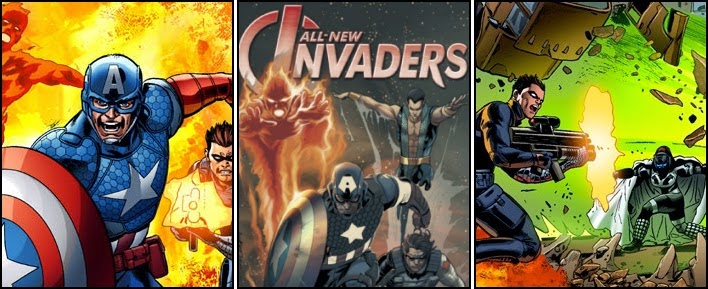 |
| SAVAGE HULK No. 4, November 2014 |
The somewhat grotesque and distinctly disturbing cover
illustration to this issue of “Savage Hulk” unfortunately seems to encapsulate
all that is wrong with the conclusion of “The Man Within”; a four-issue story
arc written and drawn by Alan Davis
which once seemed full of promise in recapturing the late 1960’s exploits of Bruce
Banner and the original X-Men.
The portrait of the Hulk is beautifully drawn by
the British artist with some genuinely inspirational pencilling. However at the
same time Davis ’
illustration also plainly depicts an alarming perversion of the green giant’s
physiology, with the Hulk suffering ‘brain bulges’ more closely associated with
his arch-nemesis The Leader. The book’s interior is equally at odds with one
another, as the comic’s pages are both well-drawn and the panels packed full of
the ‘almost cartoony’ detail the 1989 Will Eisner Comic Industry award winner
is well-known for.
But the storyline is completely unrecognisable as one
belonging to the era of writer/editor Stan Lee and Archie Goodwin. Indeed, at
one point The Leader, presumably as baffled by the turn of events as the
reader, angrily turns upon a captive Charles Xavier and asks him what is going
on. The Professor’s response is an unequivocal “I have no idea”; and he is not
the only one.
Based upon the premise that Bruce Banner’s relentless suppression
of his violent alter-ego has caused the mild-mannered scientist to vastly
increase his mental capacity and develop telekinesis blasts equivalent in power
to his formidable strength, the Hulk becomes a veritable machine of destruction,
laying waste to an entire army of the Leader’s super-strong plastic humanoid henchmen.
Luckily for all concerned this brief but cataclysmic rampage results in the
Hulk ‘burning off’ the gamma power needed to maintain his telekinetic
abilities; though not before the green-skinned behemoth has somehow destroyed
his foe’s distant secret base with an earth-shattering psychokinetic charge.
As
one can imagine such a super-powered version of Bruce Banner’s ‘greener’ side
is totally at variance with the character’s normal routine (of the time) of
simply getting angry, pounding a few objects or people or both, and then
leaping away to the next adventure. Alan
Davis’ ludicrous incarnation is therefore disconcerting and badly jars with
normal expectations. As a result it is with some relief that this book’s final
panel depicts a ‘normal’ looking Hulk bounding away from the X-Men as it
confirms that Stan Lee and Jack Kirby’s co-creation is once again safe from the
hands of Davis; an artist who with this particular four-issue run has shown
himself to be an infinitely better drawer than writer. Indeed the entire plot
of “The Man Within” is best encapsulated by the words of the title’s main
antagonist, the Leader… “I have indulged this farce long enough.”
 |
| The variant cover art of "SAVAGE HULK" No. 4 by Dale Keown |


































